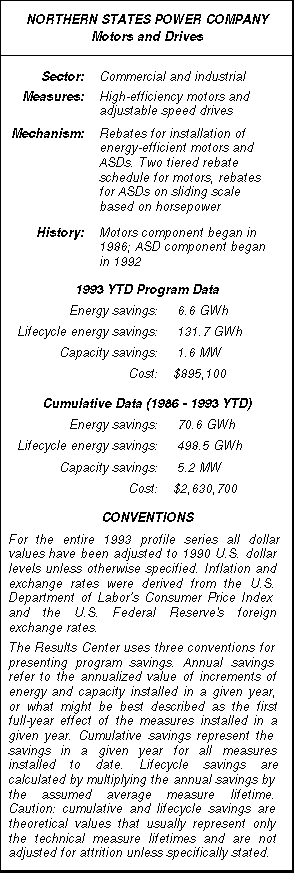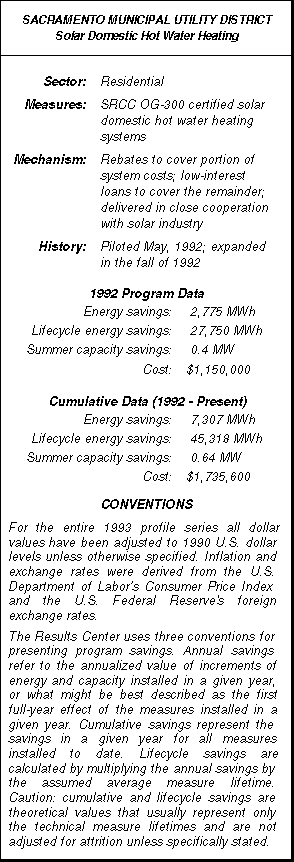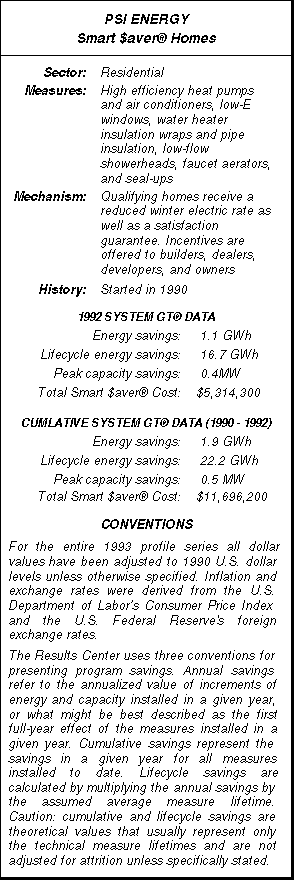EXECUTIVE SUMMARY
 To the credit of Northern States Power and its focus on the promotion of energy-efficient motors and drives, the utility has recently been invited to Washington, D.C. to attend the signing of a new U.S. Department of Energy, Environmental Protection Agency, industry, and utility compact called the "Motors Challenge." Four utilities have been invited to attend the signing and to participate in the kick-off of this new public/private sector partnership to promote the efficient use of energy in drivepower systems.
To the credit of Northern States Power and its focus on the promotion of energy-efficient motors and drives, the utility has recently been invited to Washington, D.C. to attend the signing of a new U.S. Department of Energy, Environmental Protection Agency, industry, and utility compact called the "Motors Challenge." Four utilities have been invited to attend the signing and to participate in the kick-off of this new public/private sector partnership to promote the efficient use of energy in drivepower systems.
Northern States Power has been offering its commercial and industrial customers energy-efficient motor rebates since 1986 and expanded its program to encompass rebates for energy-efficient adjustable speed drives in 1992. At the same time, it increased its rebates for motors to ramp up participation and boost energy savings.
One of the features of NSP’s program is that it provides its customers with a two-tiered rebate schedule. Smaller per horsepower rebates are offered for motors in new applications to reflect the marginal costs of high efficiency motors, while larger rebates are offered for the replacement of standard efficiency motors in existing applications. In addition to providing rebates, NSP offers its customers free motor testing to demonstrate the potentials for energy-efficient motors. Vendors of energy-efficient motors are also provided with rebates and are treated specially, as NSP considers its trade allies very important to the success of the program.
For adjustable speed drives, NSP offers several rebate levels based on the size of the drive. The highest per horsepower rebates are offered for smaller applications, while the per horsepower rebate is reduced for larger applications.
NSP has also taken direct steps to overcome one of the classic problems with moving customers to the use of energy efficient motors: many motors are embedded in pieces of equipment, such as compressors and fans. As such, NSP offers rebates to its customers for motors in "OEM or original equipment manufacturer" applications. Thus customers will put pressure on OEM manufacturers by specifying energy efficient motors in these applications.
Another attractive aspect of NSP’s Motors and Drives program design is that purchases of energy-efficient equipment can be financed through NSP’s Energy Financing program. While used almost exclusively for lighting installations to date, NSP disbursed close to $11 million in low-interest loans for energy-efficient equipment to its commercial and industrial customers in 1992. The intent of the financing program is to facilitate participation in DSM programs by removing the up-front financial barrier of purchasing conservation measures. Customers pay back their loans on their NSP bill, using a mechanism similar to an energy service charge.
[CLICK HERE TO DOWNLOAD THE ENTIRE 20 PAGE PROFILE IN PDF FILE FORMAT]
This profile was produced by

 Sacramento Municipal Utility District (SMUD) is rapidly building an impressive reputation as a utility that is aggressively pursuing energy efficiency and renewable energy. In fact, largely due to the early retirement of the Rancho Seco nuclear power plant, SMUD is facing severe capacity constraints and has developed plans to secure 800 MW from its demand-side management programs and 400 MW from renewable sources.
Sacramento Municipal Utility District (SMUD) is rapidly building an impressive reputation as a utility that is aggressively pursuing energy efficiency and renewable energy. In fact, largely due to the early retirement of the Rancho Seco nuclear power plant, SMUD is facing severe capacity constraints and has developed plans to secure 800 MW from its demand-side management programs and 400 MW from renewable sources. PSI Energy’s Smart $aver® program began as a means of promoting electrically-heated homes in Indiana but it has evolved over the years to encompass a far broader mission. The Smart $aver® program, coupled with the more recent Summer $aver® program extension, offer a series of interesting incentives for customers, builders, and vendors for the use of high efficiency heat pumps and central air conditioners.
PSI Energy’s Smart $aver® program began as a means of promoting electrically-heated homes in Indiana but it has evolved over the years to encompass a far broader mission. The Smart $aver® program, coupled with the more recent Summer $aver® program extension, offer a series of interesting incentives for customers, builders, and vendors for the use of high efficiency heat pumps and central air conditioners. While most utilities engaged in demand-side management are providing their customers with direct incentives and other services such as energy audits, analysis, and modelling, Portland General Electric has taken a lead position with its schools program. School programs represent a class of DSM programs that foster long-term value changes while serving to implement short-term retrofit measures in both schools and students’ homes. As such school programs will quite likely be the focus of additional utility attention in the coming years.
While most utilities engaged in demand-side management are providing their customers with direct incentives and other services such as energy audits, analysis, and modelling, Portland General Electric has taken a lead position with its schools program. School programs represent a class of DSM programs that foster long-term value changes while serving to implement short-term retrofit measures in both schools and students’ homes. As such school programs will quite likely be the focus of additional utility attention in the coming years.